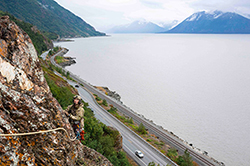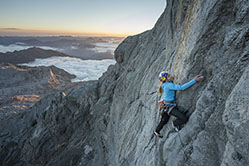| |
Everest Challenge: Climbing Toward a Greater Purpose
By Army Spc. Kimberly Gonzalez, 10th Special Forces Group (Airborne)
November 16, 2022
Going up, trying not to hold anyone back, Jason Howell pushes himself up a mountain. For every two steps forward, he pauses, catches his breath and continues up. As Howell gets closer to the summit, he begins to hyperventilate, but he does not give up and gets closer and closer until his body cannot take it anymore and his vision fades away. Moments later, he wakes up and notices that he is face down in the snow.
Howell started his military career in 2003 by joining the United States Marine Corps. He then took a break in service in 2009 and eventually joined the United States Army in 2012, where he became a green beret. He has been a mountaineering instructor at the Special Operations Mountain Warfare Training Center in Colorado for almost three years.
In 2018, Howell and his wife took a trip to Nepal and did the trek to Everest Base Camp. That was the first time he saw the tallest mountain in the world, Mount Everest. He told himself if he ever got the opportunity to climb the 29,032-foot peak, he would want to, but not like everyone else.
"I would want to try it without supplemental oxygen because I want to test my physical capabilities, my technical proficiency, my physical fitness, my mental strength, fortitude and decision making," said Howell. "I want to test myself as I am. Do I have what it takes to climb that mountain?"
Howell would wake up between 2 and 3 a.m. and conduct trail runs through the mountains. As a military mountain instructor, this also helped him with his physical fitness by continuously moving and working up in the mountains. He also studied before his quest by reading books, blogs, stories and watching movies and documentaries, which made him knowledgeable about what he would encounter.
"Everything in my life was fully encompassed and devoted to that goal," said Howell. He trained for about a year and a half to prepare himself for one of the most dangerous climbs in the world. Despite all of his training and preparation, Howell needed to factor in two critical elements.
"I have rheumatoid arthritis and Raynaud's ," said Howell. "If anything goes wrong at that altitude without the use of supplemental oxygen, there's going to be consequences."
Howell's journey from start to finish was scheduled for about two months and included traveling to Nepal, six weeks climbing in temperatures about 20 below zero, and traveling back home. Howell ascended the mountain, and along the way, his body slowly began to acclimate. The challenges started closer to the top of the mountain because there was little to no oxygen at that altitude. Howell continued to push his body to the limits until it finally shut down.
Waking up with a face full of snow and realizing the critical situation he was now in, he decided to use supplemental oxygen.
Howell said he was pretty messed up at this point. He was trying to focus, breathe and do what he needed to do: get to the summit and back down safely. Howell had been climbing throughout the night with visibility limited to only what his headlamp would allow him to see.
"I had no idea how close to the South Summit I was," said Howell. "We continued for 15 minutes, and there I was."
Howell's determination to climb Mount Everest without supplemental oxygen came short by 200 vertical feet.
"It's been tough for me not to focus on my failure or me failing my attempt without supplemental oxygen," said Howell. "I definitely learned more about my body's physiology, listening to my body and adjusting, especially at high altitude now moving in the mountains."
During the descent, Howell helped people in his group back down. Even though he was facing his challenges, as a leader, he ensured everyone else was okay and waited for everyone to come back together.
"It is pretty unfathomable to think that I could take 60 days of leave and attempt to accomplish something as dangerous as this climb was," said Howell.
Howell is extremely grateful to have been granted permission by his chain of command and direct leadership for the opportunity to attempt this climb.
"Lead by example, always lead from the front," said Howell. "Take care of your men and they'll take care of you."
"In our community in general, we're all very type-A, very driven individuals," said Howell. "To achieve anything, you have to have that mentality, mindset and personality of this is my goal, this is my objective and I'm going to do whatever it takes to achieve this."
Howell's mental and physical strength has helped him achieve many goals in life. Being a member of Green Berets Racing has also helped him have an outlet from any obstacles and to find a purpose for bigger and better things. He is fortunate to have a great support system from his friends, family and especially his wife. His mindset and drive to push himself more every day have led him to incredible life journeys that have set the path to success.
"Even though I successfully made it to the top of Mount Everest, my goal was to do it without supplemental oxygen. It was a battle for me to accept that, but the goal was to the summit and the priority is always to come back home," said Howell. "And that's exactly what I did."

Alaska Climb
Air Force Capt. Travis Hunt climbs a rock face during mountaineering training at Sunshine Ridge, Alaska; DOD |

Big Wall Ascent
American climber Sasha DiGiulian has made a career of overcoming the odds and she made history again. |
|
|
|

